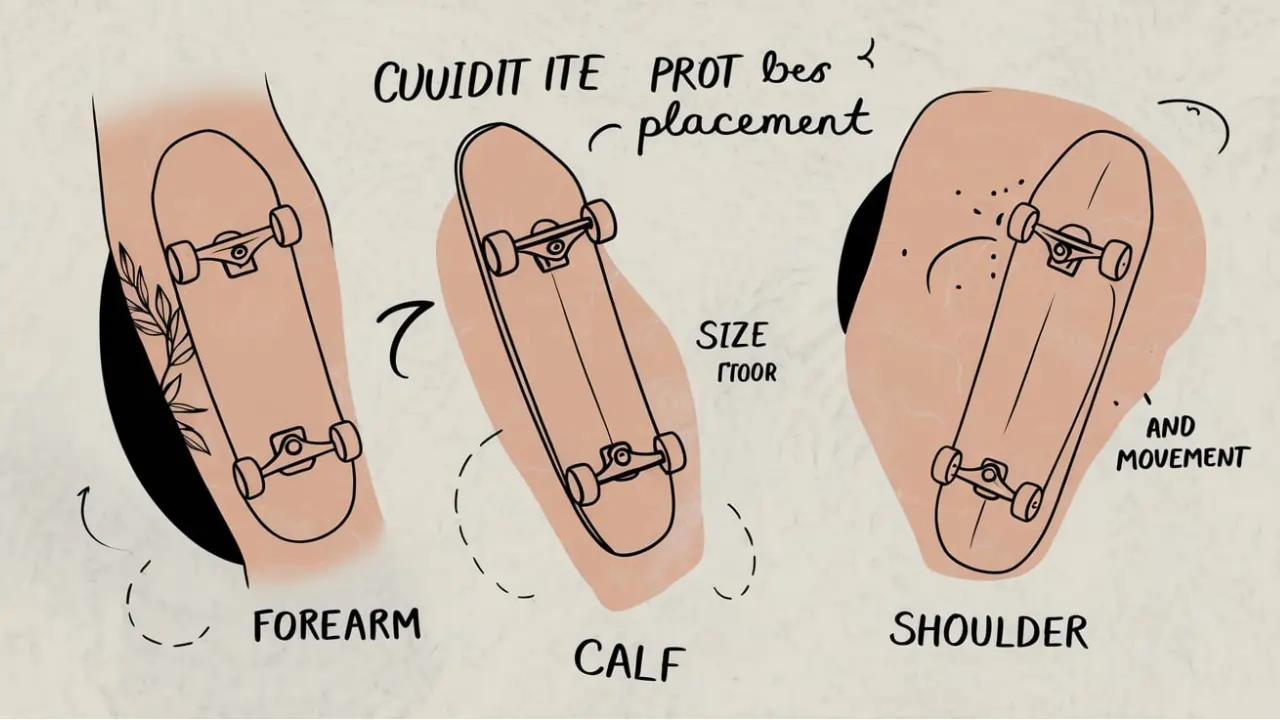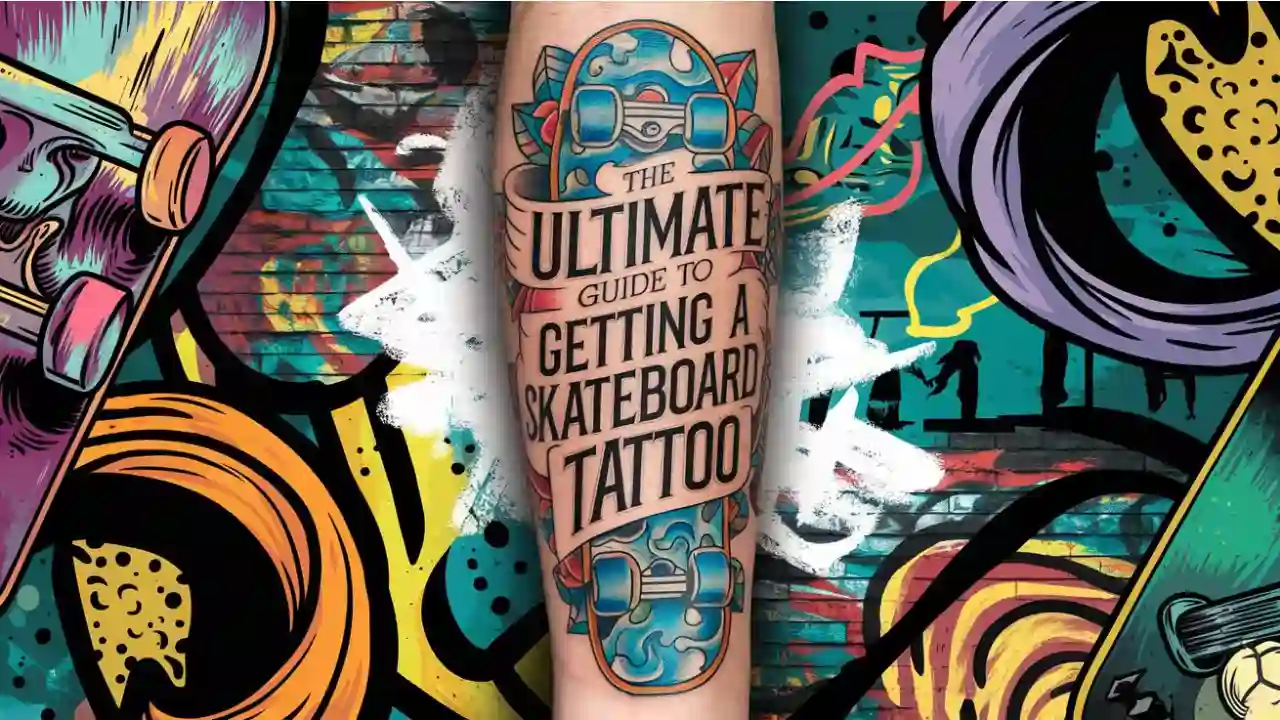Skateboarding is more than a sport; it’s a lifestyle, a culture, and a means of self-expression. Many skateboard enthusiasts consider getting a skateboard tattoo the ultimate homage to their passion.
You may want a skateboard tattoo for many reasons, whether you are an experienced skater or love the aesthetic. However, there are several things that you should know before getting inked, and this comprehensive guide will help you understand all of them.
Table of Contents
Why a Skateboard Tattoo?
A Symbol of Passion
A skateboard tattoo is more than ink on the skin for those deeply immersed in the skateboarding culture. An important part of skating is the sense of community among skaters, the thrill of riding, and the lifelong commitment to the sport. A tattoo that tells your story can incorporate bold lines, intricate designs, and personal symbols. Skateboard tattoos are not just artistic expressions but also a deep connection to skateboarding.
An outline or a complex, detailed design, a skater’s tattoo is a permanent reminder of their journey, triumphs, and challenges. Many skateboarding legends also inspire them along the way, so they pay tribute to them. It’s a way to say, “I’m a part of this culture,” without saying anything.
Aesthetic Appeal
Even if you don’t skate, a skateboard tattoo’s sleek, dynamic design can appeal to the eye. An elongated shape can attract attention, often accompanied by wheels, skulls, or flames. Whether you choose an abstract design or a realistic depiction, this style of tattooing allows you creative freedom.
Due to their adaptable form, skateboard tattoos can be applied to various body parts. They have an edgy, rebellious aesthetic that is synonymous with skateboarding. Skateboard tattoos can be minimalist or vibrant and colorful. They can be as subtle or bold as you want, with endless customization options.
Choosing the Perfect Design

Classic Skateboard Designs
One of the most popular skateboard tattoo designs is the classic skateboard design. You can choose an outline of a skateboard or a more detailed representation, complete with wheels, trucks, and deck graphics. You should select something that immediately identifies you as a skater. Classic skateboard designs are timeless, capturing the essence of skateboarding in a straightforward and impactful manner.
Depending on your preferences, it can be stylized with intricate details or kept simple. A skater’s tattoo is usually a unique representation of their individuality, often featuring iconic skateboard brands or their custom deck designs. The skateboard itself is less important than what it represents – freedom, creativity, and a passion for skating.
Incorporating Personal Elements
The best way to make your skateboard tattoo unique is to include personal elements. A skatepark name that holds special memories, a signature trick that defines your style, or even the logo of your favorite skate brand. Adding personal touches ensures that your tattoo isn’t just a generic design but a reflection of your skating journey.
A skateboard tattoo can be transformed into a meaningful work of art by adding personal elements. A tattoo can include the name of your first skateboard, the date of a significant competition, or a quote that motivates you. Many skaters include symbols representing their skate crew or memorializing a fallen friend. As a result of these personal touches, the tattoo is a tribute to skateboarding and the skater’s life and experiences.
Popular Themes in Skateboard Tattoos
Skulls, flames, and graffiti are among the most popular skateboard tattoo themes. They are often found in skate culture and can give your tattoo a rebellious edge. Street art and graffiti styles are also popular, giving your tattoo a gritty, urban look.
Symbolizing the danger and adrenaline skateboarding entails, skulls and flames are prominent, while graffiti highlights its street roots. You can connect your tattoo to skateboarding culture by incorporating these themes. Skaters often associate these designs with skateparks and streets where they honed their skills. Skateboarding also appeals to those who enjoy the raw, unfiltered nature of its scars and bruises.
Placement Considerations

Visible vs. Hidden
Placement of your skateboard tattoo is one of the first decisions you must make. Skateboarding lovers often choose visible placements like the forearm, wrist, or calf. Alternatively, you can place it on your chest, back, or upper thigh if you prefer something more discreet. Depending on how openly you want to display your skateboarding passion, the visibility of your tattoo can reflect that. You can connect with others who share your interests by wearing visible tattoos.
Conversely, hidden tattoos are more intimate and reserved for close family and friends. They can be just as meaningful without being constantly on display and offer a sense of privacy. Professional considerations may also influence your placement choice, primarily if you work in a field where visible tattoos are not permitted.
Size Matters
It depends mainly on where and how detailed you want your tattoo to be. Intricate designs cover the entire forearm or back, while a small, simple skateboard outline might fit nicely on the wrist or ankle. Consider how much space you need to include all the elements you want. A tattoo’s size will also determine how much detail it can incorporate. A large tattoo can have intricate elements like detailed deck graphics or multiple skateboards.
Even smaller tattoos can be as impactful if the design is well executed. The size of your tattoo should consider how it will age and how much of a statement you want it to make. You can use a large piece as a centerpiece of your body art if you commit to it.
Symmetry and Flow
Make sure your tattoo fits with your body’s natural curves and lines. The symmetry and flow of your tattoo are crucial for making it appear balanced and aesthetically pleasing. A skilled tattoo artist will assist you in determining the best placement to enhance the design’s overall impact. The long, rectangular shape of skateboard tattoos must be aligned correctly on your body to ensure symmetry.
Your tattoo should flow naturally with your body’s contours, making it appear to belong there. A well-placed tattoo can enhance your physique, draw attention to certain areas, or harmonize with your body shape. Discussing these aspects with your tattoo artist during your consultation is essential to ensure that the final piece looks good immediately and over time.
Choosing the Right Tattoo Artist

Experience with Skateboard Designs
Finding a tattoo artist with skateboard design experience is critical since not all tattoo artists are alike. Find tattoo artists with a portfolio that includes skateboard tattoos or similar styles. The design will be executed precisely because they will understand the nuances. A skateboard tattoo artist will be familiar with the elements that make these designs stand out.
From the shape of the skateboard to the style of graphics, they will know how to incorporate skateboarding culture’s unique details. Furthermore, an experienced tattoo artist can provide valuable input on the design and placement, ensuring that the tattoo lasts as long as possible. Your vision can be transformed into a piece of art by the right artist that you’ll be proud to wear for the rest of your life.
Portfolio Review
Be sure to review an artist’s portfolio before committing. Their work should be clean, consistent, and creative. Examine how they incorporate personal elements into their tattoos and handle complex designs. With a good portfolio, you can be confident they can realize your vision. Understanding an artist’s style and capabilities requires a portfolio review. A portfolio showing versatility and attention to detail is a good sign.
If you’re considering a tattoo, the portfolio should include examples of similar tattoos to give you an idea of what to expect. It is essential to consider the artist’s ability to work with different skin tones and body types since this can affect the final look of your tattoo. Portfolio reviews will also reveal the artist’s strengths and potential weaknesses, allowing you to make an informed decision.
Consultation Process
Consultations allow you to discuss your ideas with the artist. Great tattoo artists listen to your ideas, offer suggestions, and work with you to create a design that matches your vision. Considering the placement, size, and level of detail you want, they must also be honest about what will and won’t work. You’ll be able to build a rapport with the artist during the consultation, ensuring you’re comfortable with the process.
In addition, you can discuss any concerns you may have, such as pain tolerance or aftercare. Both you and the artist will benefit from a thorough consultation. In addition to explaining what to expect during the tattooing session and how to take care of the tattoo afterward, the artist should be willing to make adjustments.
Conclusion about Skateboard Tattoo
Nothing is more powerful than getting a skateboard tattoo if you want to express your love for the sport and culture of skateboarding. Each step of the process, from choosing the perfect tattoo design to finding the right artist, is crucial to ensuring your tattoo is a piece of art you will cherish for years. You can demonstrate your passion for skateboarding to others with your skateboard tattoo, so give it proper care and consideration.
FAQs About Getting a Skateboard Tattoo
1. Can you tell me how much a skateboard tattoo costs?
Skateboard tattoo prices vary widely depending on the size, complexity, and location of the design and the tattoo artist’s experience. A small, simple design might cost between $50 and $200, while a larger, more detailed piece might cost $500 or more. Consult your chosen artist for an accurate quote.
2. Can a skateboard tattoo be done in a short amount of time?
The intricacy and size of the design determine the time it takes to complete a skateboard tattoo. A tiny tattoo can be completed in under an hour, whereas a larger, more complex piece might require multiple sessions lasting several hours each. During your consultation, your artist can provide an estimated timeframe.
3. How painful is it to get a skateboard tattoo?
The pain associated with a tattoo depends on its location and how sensitive you are to pain. Pain is more likely to occur in areas with thin skin or close to bone, such as the wrist or ribs. In most cases, however, the pain is manageable. If you need breaks during the session, tell your artist.
4. Can you tell me what I should do before my tattoo session?
Preparation for a tattoo session involves keeping your skin hydrated and avoiding sunburns or cuts. Avoid alcohol and blood-thinning medications like aspirin before your appointment, and get a good night’s sleep. Dress comfortably so that you can easily access the tattoo area.
5. After getting a skateboard tattoo, how should I care for it?
Taking care of a skateboard tattoo is crucial. Keep your tattoo clean by washing it gently with mild soap and water, applying a recommended ointment or moisturizer, and avoiding direct sunlight. To ensure proper healing, follow the aftercare instructions provided by your artist.

